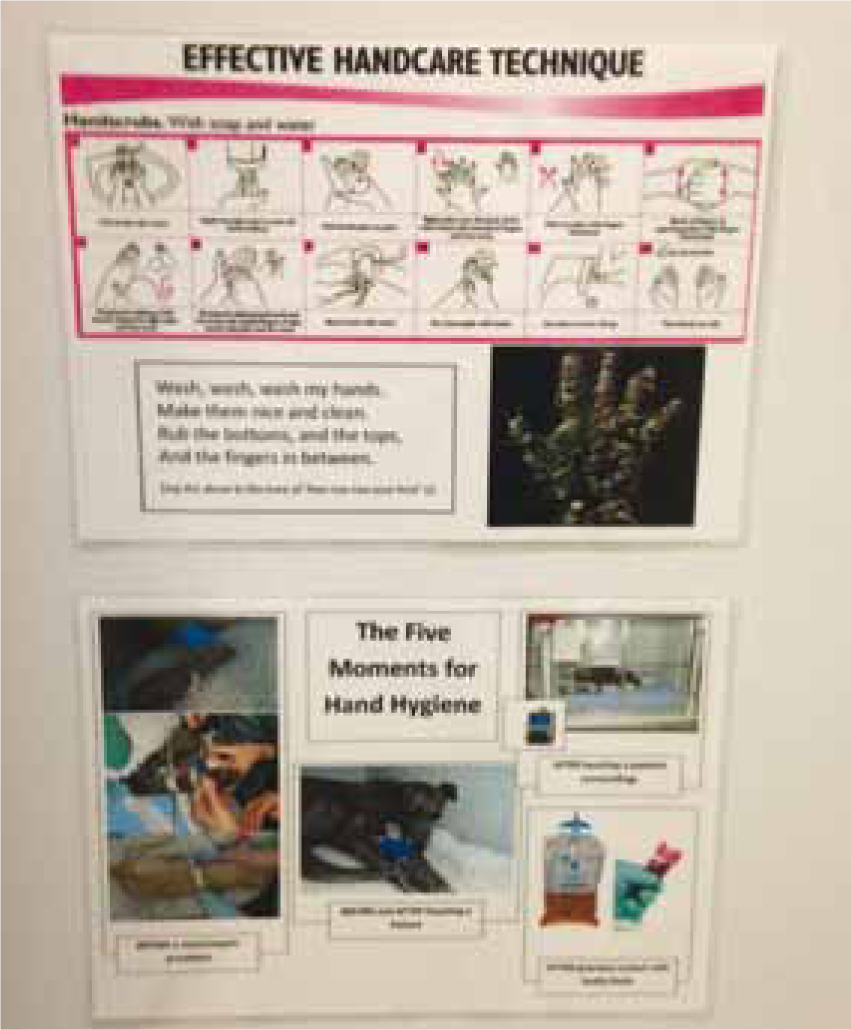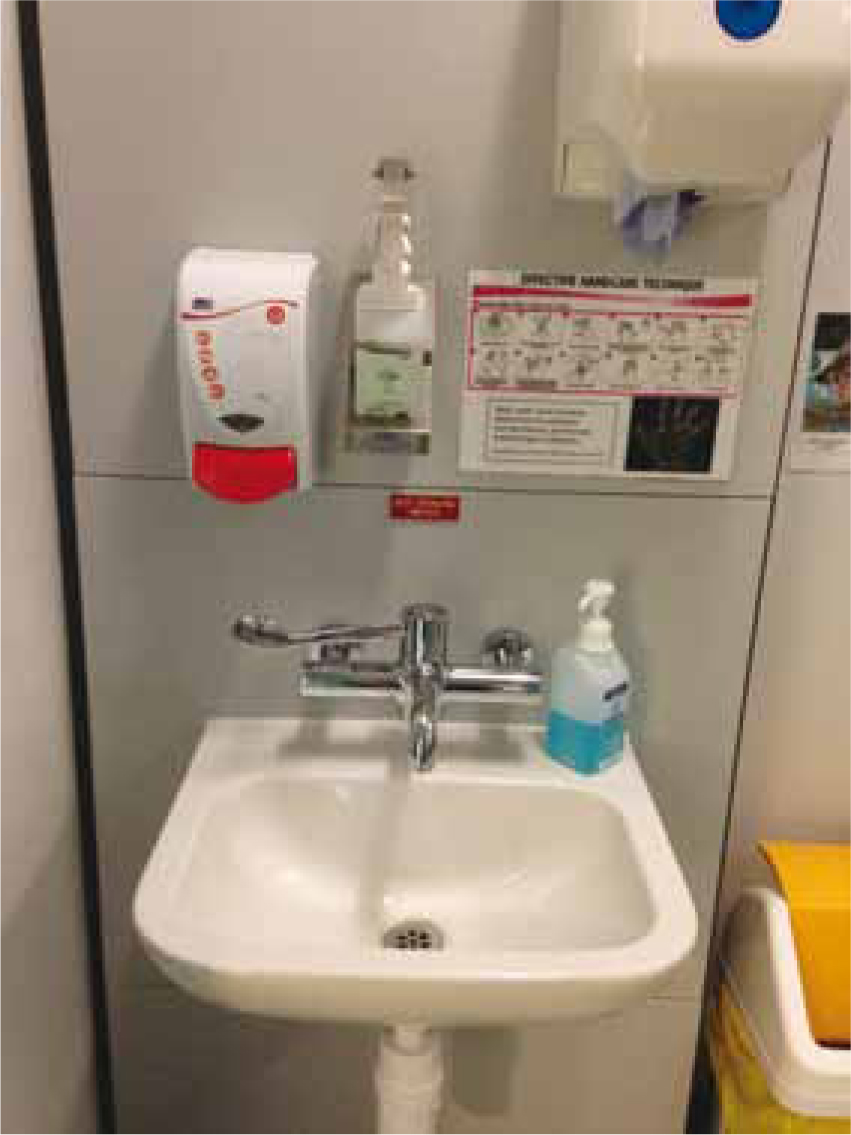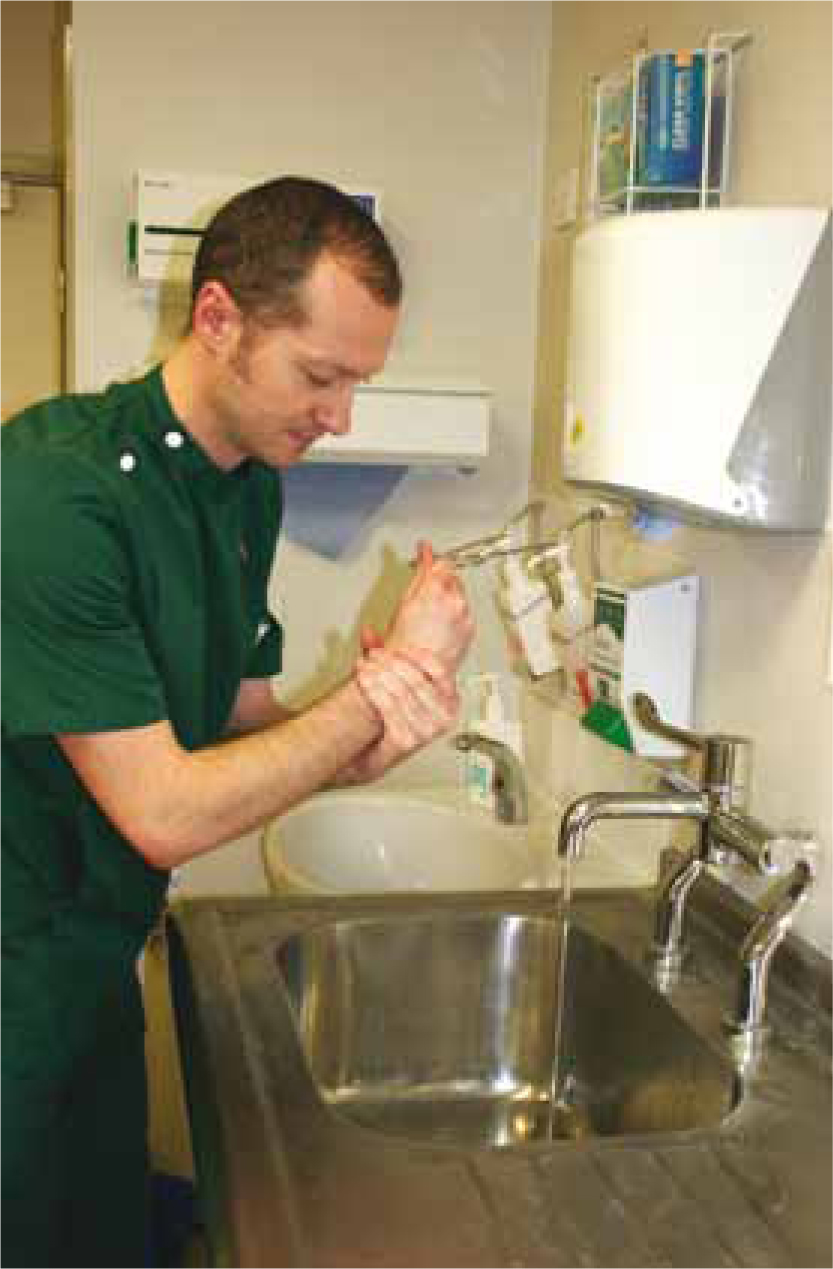In January 2008 health secretary Alan Johnson enforced a new policy on healthcare workers being ‘bare below the elbows’ (BBE) when dealing with patients, as a way of tackling the increasing problem of hospital acquired infections (or healthcare associated infections) (HAIs). This ruling went ahead despite concerns being raised in 2007 that the decision lacked evidence and was made hastily in response to much media attention around the subject of infection control at the time (Hebert, 2008).
The aims of the BBE policy are twofold: first to enable thorough handwashing to be carried out, including the wrists; and second to stop contamination of patients from long sleeves and jewellery that may be harbouring bacteria.
Many veterinary establishments have followed suit in enforcing this as a rule when dealing with patients, but there is still controversy over where the evidence is, with very little research done and what research there is suggesting that being BBE does not have any effect on bacterial counts after handwashing.
This article will explore the controversy surrounding this policy and look at the available evidence to see if there really is any benefit to the BBE rule.
HAIs
HAIs are infections which a patient acquires during a period of hospitalisation. They can take on many forms including urinary tract infections, surgical site infections and infections associated with feeding tubes and wound drains. These infections are associated with a higher rate of morbidity and mortality as well as increasing costs to the client and the veterinary practice (Gregory, 2005). More worryingly, reports of resistant bacterial infections in veterinary hospitals and practices such as meticillin-resistant Staphylococcus aureus (MRSA) and meticillin-resistant Staphylococcus pseudintermedius (MRSP) have highlighted the topic of infection control with many more establishments adopting evidence-based infection control protocols.
The true magnitude of HAIs within veterinary medicine is unknown as there is no surveillance system in place to monitor the amounts and types that are seen. The only finding of its kind by the author was a survey carried out by Benedict et al (2008) which looked at biosecurity and infection control programmes at accredited veterinary teaching hospitals. They surveyed 38 veterinary teaching hospitals on various aspects of infection control such as hygiene, surveillance and education. They found that 82% of the hospitals surveyed had reported outbreaks of HAIs in the 5 years prior to the survey being carried out, with some hospitals even closing down sections of their facilities to stop the spread of disease. This study highlights that HAIs are a real problem even in establishments such as teaching hospitals where ‘gold standard’ is paramount.
Surveillance such as this is a very important aspect of a structured infection control programme but it does rely on people reporting incidences of HAIs. As stated in the Benedict (2008) study, it is unknown whether these surveillance systems actually improve infection control or not, which probably explains the lack of compliance. Many veterinary hospitals now have infection control programmes in place but they are only reliable if every member of staff is compliant with the programme and so they remain an area with lots of work still to be done.
Public Health England are responsible for the surveillance of such topics in the human healthcare setting, but again, the surveillance is only as reliable as the people who are reporting these incidences and many HAIs may go unreported.
Hand hygiene
The topic of hand hygiene dates back to the 1840s when Semmelweis found a reduction in the incidence of puerperal fever in maternity wards when medical students and physicians began washing their hands in chloride of lime solution before attending to the mothers (Best and Neuhauser, 2004). Although times have moved on from washing hands in chloride of lime solution the same basic theory still applies.
Good hand hygiene is well publicised to be the single most effective line of defence against HAIs and the World Health Organization were at the forefront of a worldwide campaign to promote good hand hygiene in the healthcare establishments by publishing information on the Five moments for hand hygiene and The Six Steps of Handwashing (WHO, 2006; 2009). These can easily be adapted for veterinary establishments and the author's workplace has posters up around handwashing stations educating staff and students on when and how to handwash (Figures 1 and 2). Regular handwashing audits are also carried out to ensure that the correct techniques are being used at the correct times for handwashing.


According to the National Institute for Health and Care Excellence (NICE) (2012), hand decontamination is best carried out by being BBE (Figure 3) and using handrubs (which conform to British standards), such as Sterilium (BODE Chemie) apart from when hands are visibly soiled, contaminated with bodily fluids or where there is the potential for the spread of alcohol resistant organisms, when a handscrub should be used such as chlorhexidine gluconate.

What is BBE and is it really necessary?
NICE published guidelines on prevention and control of HAIs in primary and community care and these guidelines state that healthcare workers should ensure that their hands can be decontaminated throughout the duration of clinical work by:
One of the discussion points amongst human healthcare workers was the perception of professionalism that certain uniforms such as a white coat give especially amongst older patients. A questionnaire was given to patients unaware of the BBE rule and found that most patients preferred consultants to wear suits and junior doctors to wear white coats. Once they were told of the BBE policy and the reasons why they all changed their minds and said that surgical scrubs would be preferred (Ardolino et al, 2009). This shows that patients would choose infection control over dress code if given the choice and means that healthcare workers perhaps should not allow the perception of professionalism to be a barrier to compliance when it comes to the BBE rule. However, it can be assumed that the majority of patients are unaware of the BBE policy as it is not something that is well publicised in hospitals or in the media. In veterinary healthcare it would be the owners of patients that would have this view of professionalism but no similar questionnaire has been carried out. Currently there seems to be a trend for veterinary surgeons to wear scrub tops over their usual clothes and veterinary nurses to wear short sleeved tunics or scrubs thus falling in line with the BBE rules anyway, assuming that any long sleeves worn below scrub tops or tunics are rolled up.
It is well known that different types of hospital attire in both veterinary and human settings harbour bacteria such as MRSA and MRSP (Treakle et al, 2009; Singh et al, 2013) but both of these studies took samples from lapels and pockets aswell as cuffs so it is not known exactly how much bacteria was found on cuffs alone. One would assume, however that laundering of attire such as white coats takes place on a regular basis with studies such as that by Wong et al (1991) concluding that white coats should be laundered weekly. In this study, the white coats of 100 doctors were sampled as well as a survey being done on how long their white coat had been used for, what they used them for and how frequently they were changed. The study found the cuffs and pockets to be the most highly contaminated areas. Microbial counts did not vary with the amount of time in use but they did increase with the degree of use of the coat. The author feels that these two variables are very misleading and assumes ‘time in use’ to mean time the white coat was used before laundering and ‘level of use’ to mean how much the white coat was worn by an individual on a day to day basis. It was concluded that aprons should be worn rather than white coats when dealing with patients with wounds but did not conclude that there was a reason to stop wearing a white coat in non clinical areas. Another disadvantage of this study is that it is rather dated being over 20 years old, and white coats appear to be worn less in general anyway.
Willis-Owen et al (2010) carried out a study on 92 doctors working in a general hospital, 49 BBE and 43 not. Their fingertips were imprinted onto culture medium and this was assessed for colony forming units, clinically significant organisms and multi-resistant organisms. No multi-resistant organisms were found in either group nor was there any statistical significance found between the two groups and the number of colony forming units or clinically significant organisms.
This study only looked at the effect of clothing on hand contamination rather than the effect of clothing and wrist and hand jewellery on hand decontamination so although it cannot support the theory that being BBE makes a significant difference to hand contamination, it cannot say whether being BBE has any bearing on effective hand hygiene. It really only looks at half of the reason for the BBE ruling and so the author feels that the study cannot fully be unsupportive of it.
As well as the potential for bacterial contamination from cuffs there is also the issue of rings, wrist watches and other jewellery worn around the wrist. There is conflict surrounding the banning of wrist watches as discussed in a study which looked at bacterial contamination on the wrists and hands of those who wore watches compared with those who did not (Jeans et al, 2010). Those who wore watches had a higher bacterial load on the wrist but not the hand but the same people who then removed their watches before having swabs of the hand taken showed higher bacterial counts on their hands which was associated with the removal of their watch. This suggests that the problem lies with removal of the watch rather than the simple fact of wearing a watch in the first place. With this in mind, healthcare workers who need to remove a watch should decontaminate their hands after removal of the watch or alternatively not wear a wristwatch in the first place. This study therefore supported the BBE policy provided that wrist watches are substituted for other items such as fob watches. It could be argued, however, that fob watches are also handled and so the same contamination of hands could potentially occur. Similarly the wearing of rings has been found to increase bacterial counts 10 fold (Trick et al, 2003) as well as being a barrier to effective hand hygiene. Unlike the Willis-Owen et al (2010) study, this one looked at both hand contamination from wearing a ring but also the efficacy of hand decontamination while wearing a ring.
Another study was carried out that looked more closely into the effect of being BBE on hand decontamination (Burger et al, 2011); it studied two groups of human healthcare workers who were either BBE or not BBE (38 and 28 respectively), and determined whether there was any significant difference in the number of bacterial colonies found after handwashing between the two groups. This study confirmed that handwashing produces a significant reduction in bacterial colonies on the fingers, palms and dominant wrist, but did not find any significant difference between the two groups. It also revealed that before handwashing there were more bacterial colonies found on the group who were not BBE compared with those who were BBE, but again this was not significant.
In response to this study, a comment in the same journal by Griffin et al (2011) brought to light some issues with this study; it pointed out that the study focused more on the issue of clothing around the wrists while neglecting to look at the issue of jewellery. There were participants in both groups reported to have been wearing jewellery and watches, and previous studies, such as that by Trick et al (2003), have shown that wearing jewellery can increase bacterial counts 10 fold, so this could have had an effect on the results gained.
In the same comment it was also highlighted that those who were not BBE may have performed a more thorough handwash at the time thus perhaps increasing the element of bias in the study. This element of bias could be relevant in all studies comparing BBE and not BBE due to the inability to ‘blind’ participants.
Making a change
In order to add this BBE rule to existing hospital policies on infection control, a clinical audit should be carried out in order to review on a regular basis whether this addition has made any difference, be it positive or negative, to the quality of care provided. As quoted from Viner (2005: 216): ‘A clinical audit is a quality improvement process in clinical practice that seeks to establish protocols for dealing with particular problems, based on documented evidence when it is available, monitoring the effectiveness of these protocols once they have been put into effect, and modifying them as appropriate. It should be an ongoing upwards spiral of appraisal and improvement’.
Once the BBE rule has been established, the performance should be reviewed and changed accordingly, for example, in this instance the areas which would need to be monitored would include compliance (including barriers to compliance), whether there is an improvement in handwashing techniques and whether there is any significant difference to infection rates of patients within the workplace. Part of the Epic 3 guidelines (Loveday et al, 2014), which is a large evidence base for infection prevention and control recommendations in the NHS, states that hand hygiene guidelines should be audited at regular intervals and results fed back to healthcare workers to improve and sustain high levels of compliance.
Unlike in human hospitals the author believes that uniform (i.e. white coats) and the perception of professionalism will not be as much of a barrier to compliance with a BBE policy, but what might cause a problem is again, the overall lack of evidence. This is where a clinical audit can show performance levels and at the least will hopefully show that there has not been an increase in HAIs and that infection levels have stayed minimal.
Conclusion
In conclusion it can be said that there is much conflict around the BBE policy especially amongst human healthcare workers. It can be argued that it is proven that bacterial counts on cuffs and around watches and rings are higher than other areas and therefore should not be worn when dealing with patients. There is, however, no significant difference in bacterial load after handwashing between those who are BBE and those who are not. It could be said then that there is no harm in adopting a BBE policy in your establishment, but particularly for those who believe in establishing a strong evidence base for a change in policy there may be some issues with an area such as this with so little evidence.
More studies need to be done especially in veterinary establishments and also with larger sample sizes to determine first, the amount of bacterial contamination on long sleeves and jewellery worn by veterinary staff, but also whether being BBE has any effect on decontamination of the hands. The element of bias would be difficult to address in this situation as it would be impossible to ‘blind’ a participant as to whether they were BBE or not when performing handwashing techniques.
If adopting a BBE policy the establishment could carry out a clinical audit to investigate whether such a change has an effect on infection rates. In addition, it would be beneficial to observe the response of staff members on undertaking such a policy, to monitor for compliance, and where compliance is low then to explore and diminish any barriers that there may be.
Key Points
Conflict of interest: none.

